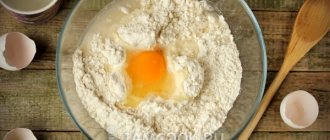Salad "Mother-in-Law's Tongue"
Ingredients: 6 kg of zucchini, 1 kg of bell pepper, 250 g of garlic, 1 pc. hot pepper, 800 g tomato paste, 200 g sugar, 250 ml water, 400 ml sunflower oil, 3 tbsp. l. salt, 200 ml 9% vinegar, 10 pcs. carnations, 15 pcs. allspice, 30 pcs. peppercorns.
Preparation: cut the zucchini into thin slices, the bell pepper into strips. Chop the garlic. Remove the seeds from the hot pepper and cut it into pieces. Place all the prepared vegetables in a large enamel pan, add salt, sugar, sunflower oil, spices (to taste). Dilute the tomato paste with water and add to the total mixture. Place the pan on the fire, cook for half an hour over low heat under the lid. 5 minutes before the end of cooking, pour in the vinegar. Place the salad in jars and roll up.
Photo: Shutterstock.com
Casserole
Another very economical option is zucchini casserole in bechamel sauce. Bechamel is generally an excellent solution when you need to make a large amount of food for three pennies - after all, you only need a liter of milk, 2-3 tablespoons of flour and the same amount of butter. To prevent zucchini (cut into circles) from leaking in the casserole, they must either be pre-fried or salted and allowed to drain - but in this case the loss of volume will not be so enormous. The casserole can be enriched with some grated cheese (hard or, on the contrary, young - you need one that melts well) or cottage cheese, chopped herbs, garlic, ginger or spices. A casserole with cumin and coriander will be very different from a casserole with dry Italian herbs. If you want to get the most “zucchini” taste, add only nutmeg to the bechamel on the tip of a knife.
Zucchini casserole with cheese
Zucchini casserole with cheese
Salted zucchini with horseradish
Ingredients: 1.5 kg of zucchini, 1 bunch of dill, 2 tbsp. l. salt, 1 head of garlic, horseradish root (1 cm), 1 chili pepper, 1 liter of water.
Preparation: Cut off the stems of the zucchini. Dissolve salt in boiling water, boil for 2 minutes, cool. Place a third of all herbs and spices at the bottom of the jar, add zucchini, then another third of the spices and herbs. Again zucchini and again greens on top. Fill everything with brine and leave for 10 days. Then add brine to the neck of the jar and close with a plastic lid. Store in a cool place.
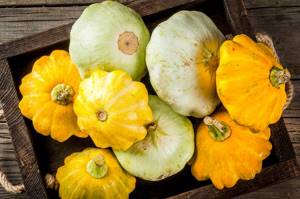
Correct squash. How to grow fruits suitable for canning? More details
Why do I choose yellow squash?
My first zucchini appears in mid-June. I usually plant at least 5-6 varieties. And definitely - a couple of yellow-fruited ones. Their fruits do not overgrow for a long time, their pulp is more tender and juicy, and the caviar has a more natural color. They are also an excellent choice for canning. And most importantly, yellow zucchini adds a bit of sunshine to cooked dishes.
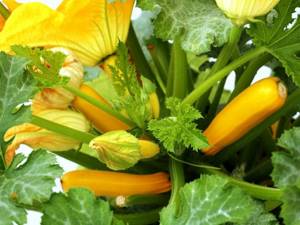
What is not a flowerbed
Zucchini is a very elegant crop, especially the zucchini variety. They have luxurious rugged leaves, often decorated with a silver or golden lace pattern, and huge yellow or orange bell-shaped flowers. But the most beautiful fruits are cylindrical or spherical, yellow, dark green, almost black, striped or variegated. Yellow zucchini is especially impressive. At the time of flowering and fruiting, each of their bushes can compete with a small flower bed in terms of decorativeness.
Demanding but grateful
In order to get early production, I grow all zucchini through seedlings. First, I germinate the seeds in plastic containers with lids. I pour a small layer of seedling soil on the bottom, water it, spread the seeds on the surface of the soil, close the container and put it in the warmest place. I ventilate the crops once a day. As soon as the sprouts begin to hatch, I open the lid slightly, placing matches on the sides of the container. As the seedlings develop, I increase the gap. I transplant well-developed seedlings with roots and two open cotyledons into pots.
I plant seedlings in the ground at the age of 20-25 days. If the weather is cold, I cover the top with non-woven material. It is better if it is thrown over the arcs.
Read: The chairman squandered money, how can I get it back?
I prepare the bed in advance. At the bottom I place cut stems of raspberries, Jerusalem artichokes, tops of carrots, beets and any garden debris, which any gardener has a lot of left over by autumn. In the spring, I pile last year’s grass and half-rotted compost there, and cover everything on top with fertile soil. I do not apply mineral fertilizers. As soon as the weather permits, I water the holes with warm water and plant the zucchini.
Yellow-fruited zucchini begins to show its character immediately after sowing. They usually emerge later than everyone else and develop slowly.
In the garden beds, yellow-fruited plants are also capricious for a long time. Their fruits set 5-9 days later than others. The earliest ripening zucchini is grey, then green, followed by striped ones, and only after them yellow ones appear. In cool weather, their ovary rots more often than all other zucchini. Therefore, at the beginning of flowering, I remove 2-3 large leaves from the middle of the bush. This provides a greater influx of sunlight to the ovaries. During the rainy season, I always remove the remains of the corolla petals from the young ovaries, which often also become a source of rotting of the fruit.
However, the slightly slower development of yellow-fruited zucchini at an early stage of growth only benefits gardeners. After all, they ripen slower than other zucchini, which means they remain tender longer, and they always have few seeds. After marinating, they retain their bright yellow hue and look very beautiful. Fruits up to 10 cm in size can be rolled whole into jars.
ON A NOTE
I usually plant zucchini plantings with early-ripening green crops: lettuce, mustard, arugula. After a month, they are already moving away, and the matured zucchini has more space to grow.
Special Purpose
Zucchini is a versatile vegetable. It can be fried, stewed, canned. But there are varieties that are a pity to heat-treat, because they are very good in salads. Among these is the Zolotinka variety, one of the first sunny-colored zucchini to appear in our gardens. Its main advantages are early ripening (it begins to bear fruit on the 47th day after emergence), thin, non-aging skin and a tender center with medium-sized seeds. The fruits are cylindrical, smooth or slightly ribbed, beautiful golden-yellow in color. The pulp is yellow, dense, crispy, tender, juicy, with a sweetish taste. In the first half of the growing season, the plants are compact, in the second half they develop small vines, which does not affect the number of fruits. From one bush over the summer I pick 10-15 fruits. The weight of mature zucchini is 0.7-1.3 kg. After harvesting in the fall, they can be stored for two months. The variety is resistant to powdery mildew.
Read: Beets: choosing the “right” neighbors
Recently, the Zolotinka variety has been replaced by excellent Dutch hybrids with a predominantly female type of flowering: Gold Rush F1, Goldline F1, Sunlight F1. Of the domestic varieties, I really liked the Yellow Banana F1. True, you should not trust seed sellers who claim that it tastes like the fruit of the same name. At the same time, the fruits of this variety are excellent, long and thin, with creamy dense pulp, and do not form seeds for a long time.
You can stuff any zucchini. I cut the young, ungrown fruits in half and fill the two resulting boats with the filling. I cut a very long fruit crosswise into thin rings, remove the core from them and stuff them with minced meat. But it’s especially convenient to use round zucchini for stuffing. Among them is the yellow Orange variety. Just don’t let them overripe, otherwise the whole middle will be occupied by coarse seeds. While they are small, they are convenient containers for baking. And most importantly, even the harvest from one bush is enough for each family member to have a personal “saucepan with a lid” for lunch, filled with vegetable or meat filling, baked in its juicy pulp. Orange's bush is miniature and takes up little space in the garden. Productivity is low. 3-5 fruits grow at the same time. By the way, I didn’t notice the promised unique taste of this zucchini. In my opinion, in this indicator it is inferior to all yellow-fruited zucchini.
Read: Lobelia should be planted in bunches
But the Zheltoplodny variety showed itself to be the most productive and long-lasting. Its cylindrical fruits, tapering towards the stalk, are painted a pleasant yellow color with a barely noticeable orange mesh. The weight of mature zucchini is 0.7-1.3 kg. These zucchini lasted for almost three months without loss of quality. I removed them as soon as the skin became dense, leaving a stalk 5-7 cm long.
You might be interested in:
- Zucchini at its best: growing zucchini in a barrel
- Cucumbers: I plant less and harvest more
- Harvest large pumpkins from strong seedlings
- Do membership fees depend on the area of the site?
- There is zucchini - there is food
- Sweet watermelons in Tula
Subscribe to our channel in Yandex.Zen
Squash in marinade
Ingredients: small squash (about 15 sh. fits in a 3-liter jar), dill, dill umbrellas, 1 hot pepper, bay leaf, garlic, horseradish root (small piece), horseradish leaf, salt (50 g per 1 liter of water ), 4 tbsp. l. 9% vinegar.
Preparation: sterilize the jars, peel the horseradish root. Place spices and herbs at the bottom of the jars. Blanch the squash in boiling water for 5 minutes. Boil water for the marinade, dilute salt in it, then turn it off and add vinegar.
Place squash in jars, pour hot marinade. Sterilize for 15 minutes. Roll up.
Photo: Shutterstock.com
Spicy Korean squash
Ingredients: 2 kg of squash, 700 g of carrots, 500 g of bell pepper, 300 g of onion, 350 g of garlic, 40 g of parsley, 60 ml of 9% vinegar, 120 g of sugar, 10 g of salt, 1 tbsp. l. ground coriander, 100 g sunflower oil, chili pepper (to taste).
Preparation: Wash the vegetables and leave to dry on a paper towel. Young squash does not need to be peeled. Cut the bell pepper in half, remove the stems and remove the seeds. Grate the squash and carrots (for Korean salads). Cut the pepper into thin strips. Finely chop the onion into half rings. Place the prepared vegetables in a large saucepan, stir, add sugar and salt. The vegetables have released their juice, add coriander, crushed garlic, and chili pepper. Mix the salad again until smooth. Then add finely chopped parsley. Season the salad with vegetable oil and vinegar. Stir the salad one last time. Cover the salad with a plate and place some weight on top, for example, a jar of water or a washed cobblestone. Keep the salad under load for 3 hours. Then place the salad in sterilized jars and roll up.
Photo: Shutterstock.com
Pancakes
Let's start with the pancakes.
As a rule, they are made from coarsely grated zucchini with the addition of eggs, flour and salt. This recipe has one drawback: zucchini releases a lot of liquid (and the longer the pancake dough sits, the more). There are two ways to solve this problem. First: salt the grated zucchini in advance, let them stand and squeeze. In this case, the volume of zucchini decreases simply catastrophically. The second is to add flour or semolina as the dough “liquefies”. In this case, towards the end, not a trace remains of the taste of zucchini in the pancakes; the result is almost flat cakes. But there are tricks to get around this problem. Firstly, you can add potatoes (preferably baked) to the dough - they do not change the taste much and absorb zucchini juice very well. Secondly, you can prepare a base for the dough: eggs, flour, salt - and divide it into parts, grate the zucchini in parts, mix and bake quickly so that the juice does not have time to stand out. Well, chopping the zucchini more coarsely (using a mandoline grater rather than a regular grater) helps a lot too. Zucchini pancakes with cheese

Zucchini pancakes with cheese
"Pineapples" from zucchini
Ingredients: 1.5 kg of medium-sized zucchini, 1 liter of pineapple juice (it is better to choose the most expensive and natural), 250 g of sugar, 1.5 tsp. citric acid.
Preparation: peel the zucchini, cut lengthwise, remove the core with seeds and cut the pulp first into thin half rings, and then into approximately the same pieces as canned pineapples in jars. Pour pineapple juice into a saucepan, add sugar and citric acid and boil. Place the zucchini slices in the syrup and cook them over medium heat for 15–20 minutes. They should be saturated with syrup and become translucent, but not boiled. If the “pineapples” turn out too pale, you can tint them with a small pinch of turmeric. Place the finished zucchini with hot syrup into sterilized jars, then turn them upside down and slowly cool under a blanket or in a thermal bag.
Photo: Shutterstock.com
Growing yellow-fruited zucchini in open ground
To get a good harvest in open soil, you should follow some care recommendations. Beginners should know that to get an earlier harvest, the crop should be planted using seedlings. Even with direct sowing in a permanent place, the variety gives a good result, but a little later.
Preparing soil and seeds
Well-warmed and fertile soil is suitable for the crop. Its preparation should begin in the fall. After harvesting, the land is harrowed, which promotes the germination of weeds. After two weeks, the area is dug up using a shovel, getting rid of weeds. At this time, you should add per 1 m²:
- compost bucket;
- 20 g of potash fertilizers;
- up to 35 g of superphosphate.
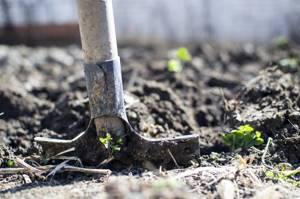
The digging depth should be at least 12 cm. After completing the work, add up to 20 g of ammonium nitrate per 1 m2 and level the soil with a rake.
In the process of growing zucchini, pre-sowing preparation occupies a special place. In the case when sowing is carried out directly into open soil, it is recommended to pre-soak the seeds, which significantly increases germination. Most purchased seeds have already undergone pre-sowing treatment. If the planting material was obtained at home, it must be kept in hot water at about 50˚C, and then placed in a Fitosporin solution.
Planting in open ground
The pickled seeds are placed in a damp cloth and transferred to a warm place. After 10 hours, you can already notice small sprouts that can be planted in the prepared soil. To grow seedlings, it is better to bury 2-3 pieces in one container.
On a note!
When planting immediately in a permanent place, you should first make small holes, the distance between which should be 70 cm. The holes are watered with warm, soft water, after which 2-3 seeds are placed in each hole no deeper than 5 cm.
In open soil, crops should be covered with film to protect them from possible frost. If plants are grown as seedlings indoors, the containers should be covered with film and placed closer to heating appliances. Seedlings can be planted in the beds after 15-20 days, when the soil temperature reaches 14˚C.
Watering and fertilizers
Yellow zucchini is a moisture-loving crop, so soil moisture should be given special attention. It is best to water early in the morning or in the evening to avoid the scorching rays of the sun. Each bush is watered with two liters of water once a week. If the summer is dry and hot, the number of waterings is increased to 2-3 times a week.
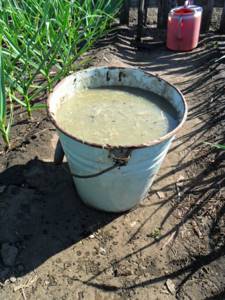
This variety responds well to organic fertilizers, for which it is recommended to use infusions of bird droppings and mullein.
Throw chicken droppings, mullein or grass into a bucket of water, cover the container with a lid and leave to infuse for 5 days. The resulting solution is diluted in the following proportion: 1 liter of the resulting mixture per bucket of warm water. It is necessary to fertilize the bushes three times: before flowering, during the flowering phase and during the formation of the ovaries.
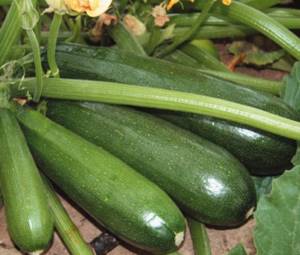
Squash salad
Ingredients: 6 kg of squash, 1 kg of carrots and onions, 150 g of garlic, 1 glass of sunflower oil, 1 glass of table vinegar, 3 tbsp. l. salt, 4 tsp. ground black pepper, 2 cups sugar.
Preparation: wash the vegetables, peel and dry. Cut the squash into cubes and grate the carrots (for Korean salads). Cut the onion into half rings, pass the garlic through a crush. Place vegetables in a large saucepan, stir, add remaining ingredients. After 3 hours, place the salad in sterilized jars, place them in a large container with water to sterilize so that the water reaches the “shoulders” of the jars. Sterilize within 15 minutes after the water boils. Roll up the jars, turn them over, cover with a warm cloth.
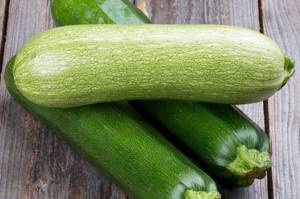
How is zucchini different from zucchini? More details
Blanks
One of our first associations with zucchini is, of course, “overseas caviar.” If it’s customary to make preparations at home, then you probably have your own signature recipe for squash caviar. What’s good about this caviar is that you can add almost any spicy vegetables and herbs that you have in your garden or on the shelves. Moreover, it is absolutely not necessary to adhere to any canons (such as “only onions, garlic, carrots and tomatoes!”). You can add all sorts of Asian ingredients to squash caviar: ginger, lemongrass, soy sauce; you can put “Italian” ingredients: basil, oregano, marjoram; you can use “Uzbek” ones: cumin, coriander, rayhan, hot pepper. All options are good and give completely different tastes.
Squash Cavier
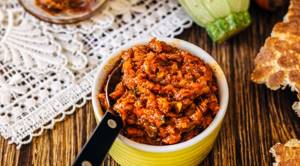
Squash Cavier






